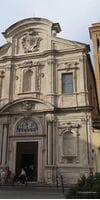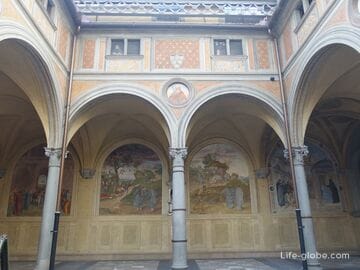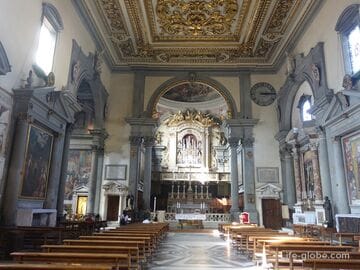The Church of All Saints or the Church of Oniissanti (Chiesa di Ognissanti) is a Roman Catholic church in Florence in the Neo-Renaissance and Baroque styles, with frescoes by Ghirlandaio and Botticelli and the graves of famous members of the Vespucci family, the Italian artist Sandro Botticelli and the Italian princess.
Full name of the church: Church of the Holy Savior and All Saints (Church of San Salvatore in Ognissanti / La chiesa di San Salvatore in Ognissanti).
The church was under the patronage of the noble Florentine Vespucci family, which, first of all, is known for the famous Amerigo Vespucci, a traveler and navigator, a supporter of the "New World" after whom, according to one version, America was named. The name "America" comes from the Latin version of the name Amerigo, that is, "Americus Vespucius". However, there is another version that also explains the origin of the name; according to which America got its name from Richard America, a wealthy merchant from Bristol, who financed the second transatlantic expedition of John Cabot, which in 1497 (two years before Vespucci) reached the shores of Labrador, and the newly discovered lands were named after the main sponsor of the expedition.
The church has a monastery with a remarkable refectory, which is considered one of the secret gems of Florence, where the famous fresco by Domenico Ghirlandaio "The Last Supper" is located.
The church is located in the historical center of Florence, on the Square of All Saints of the same name (Piazza Ognissanti), next to the palaces and the waters of the Arno River.
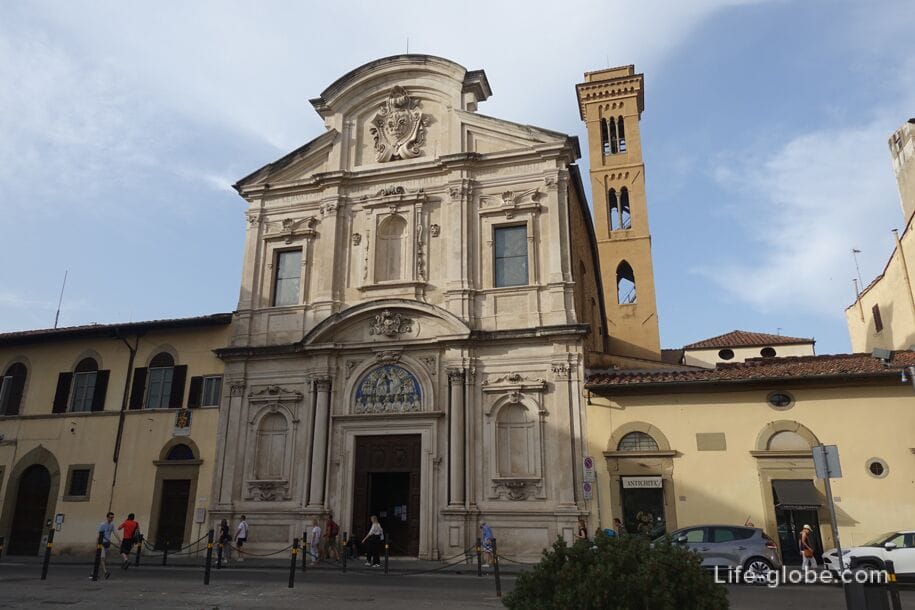
Initially, the construction of the church was started in 1251 as part of the monastery of the Umiliati Order, which came to Florence from Alessandria in 1239. The church was dedicated to all saints and martyrs, known and unknown.
The church was almost completely rebuilt around 1627 in the Baroque style by the architect Bartolomeo Pettirossi. In 1637, according to the project of the Italian architect Matteo Nigetti, a new facade of the shrine was erected, which retained a glazed terracotta lunette over the doorway, attributed to the Italian sculptor Benedetto Boulloni.
Also at the beginning of the 17th century, the interior of the church was rebuilt in the Baroque style. Thus, the church of Oniissanti was one of the first examples of Baroque architecture in Florence. Reconstructions were carried out in the 19th century.
During its history, the church was under the patronage of the noble Florentine Vespucci family.
The main facade of the church, facing All Saints Square, is divided into three sections and is distinguished by columns and pilasters with capitals surrounding niches and windows with complex cornices. Above the entrance portal stands an ancient luten depicting the Coronation of the Virgin and Saints by Benedetto Buglioni around 1510; and the upper part is dominated by an insert with the coat of arms of Florence.
To the left of the facade is a bell tower of 13-14 centuries of construction.

Interior of Onyissanti Church
Onyissanti church has one nave and a deep transept with chapels.
The originality of the interior gives the impression of almost untouched, in the context of layers of rich history, which makes it unique among the major churches of Florence.
The interior with an abundance of chapels is illuminated by rectangular windows located in the upper part above the cornice, dating back to 1627 and possibly designed by Sebastiano Pettirossi commissioned by Giovanni Battista de Ambra, whose coat of arms can be seen on the counterfacade under the cornice. Between the windows there are medallions with semi-figures of saints by the Italian artist Anton Domenico Bamberini in 1687. There is also abundant stucco work by Attilio Casini, who also created a wall clock on the right wall of the church.


On the counter facade there is a painting of the Appearance of the Madonna and Child to St. Francis by Cosimo Ulivelli in 1662, which is crowned with the coat of arms De Ambergris.
The nave of the church is covered with trusses, hidden by a suspended ceiling, which depicts the Glory of St. Francis and St. Pasquale Baylon by the Italian artist Giuseppe Romei from 1769-1779.
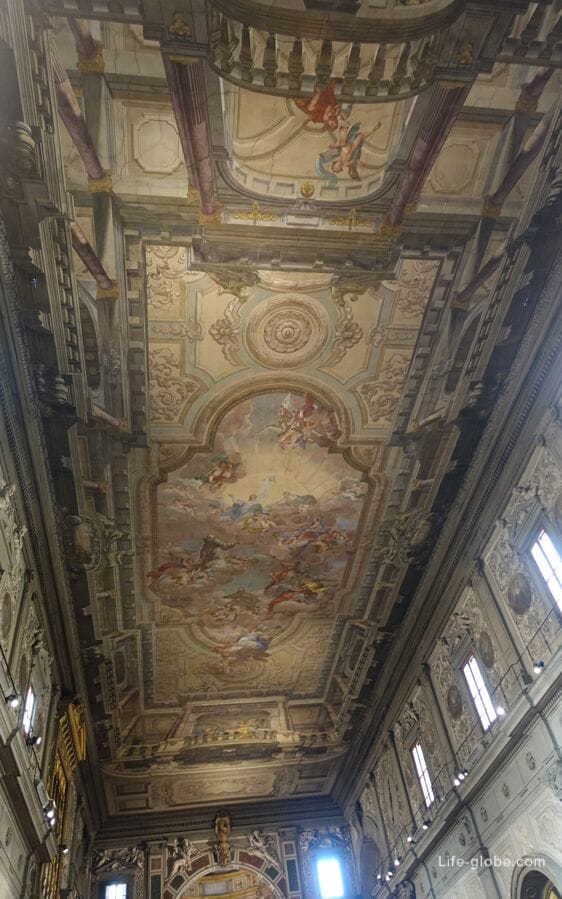
The interior is also notable for altars decorated with paintings, frescoes, columns and sculptures by Vincenzo Dandini, Sandro Botticelli, Domenico Ghirlandaio, Santi di Tito, Maso da San Friano, Nicodemo Ferrucci and others.
Notable among the altars is the Vespucci altar with the remains of the Displacement and the Madonna della Misericordia among the oldest frescoes created by Domenico Ghirlandaio (circa 1472-1475), on which he depicted his patrons kneeling under the protective mantle of the Madonna. The child depicted to the left of the Madonna is considered to be Amerigo Vespucci; next to him is a character in a white hat - Simone Vespucci, a benefactor who founded the San Giovanni di Dio Hospital in Florence (Ospedale vecchio di San Giovanni di Dio). The fresco was dim and covered with a canvas depicting St. Elizabeth by Matteo Rosselli. Next to the altar is a marble tondo decorated with the Vespucci coat of arms, which points to the crypt of the family, where its most famous members are buried, including Amerigo and the beautiful Simonetta Vespucci.
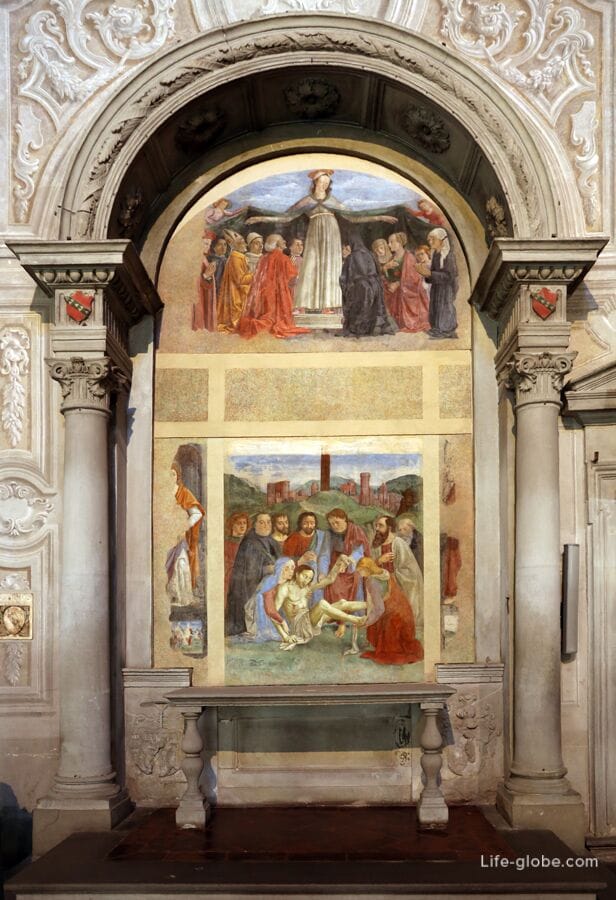
Sandro Botticelli is also buried in the church.
His burial place is marked near the chapel of San Pietro d'Alcantara, frescoed on the vault and ledges by Matteo Bonechi and on the side walls by Vincenzo Meucci (1722). In this chapel, a disk with a coat of arms (altered in 1937 according to old drawings) indicates the burial of the Filipepi family, to which the painter Sandro Botticelli also belonged. Admirers of the great artist usually write personal messages, which are thrown into a basket near the tombstone, next to which the "Botticelli Portrait" by Franco Giletta in 2018 is visible.
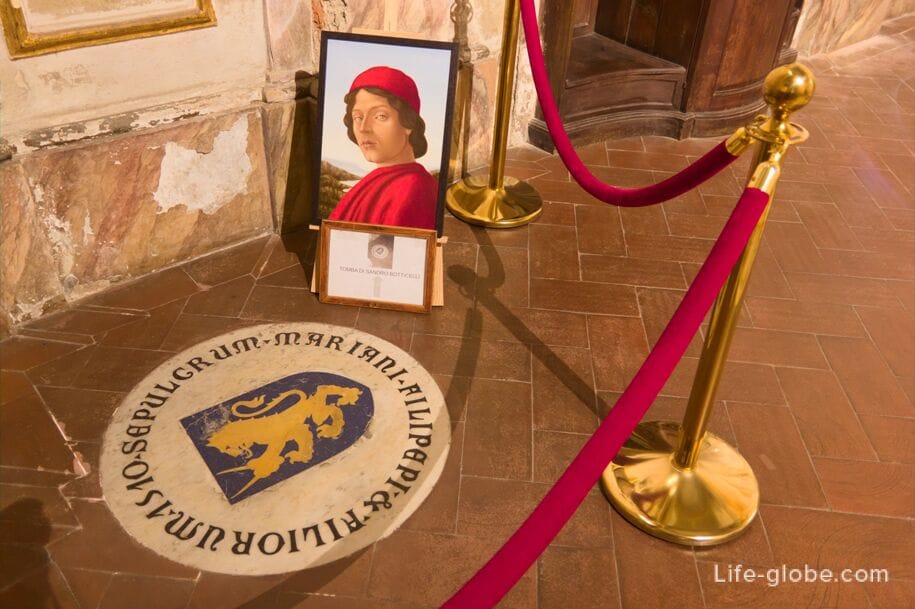
At the head of the transept of the Onyissanti Church is the chapel of the Most Holy Name of Jesus, the current form of which dates back to 1722. The dome is frescoed by Giovan Domenico Ferretti, and the squares are painted by Lorenzo del Moro. Ferretti also created two ovals on the sides of the altar with the image of the Grieving Madonna and St. Joseph. Other decorations are a canvas by Vincenzo Dandini with Saints Bernardino and Giovanni da Capestrano and two side paintings with the approval of devotion to the name of Jesus and the death of San Bernardino of the Florentine school of the late 16th century. A small door in the right wall of the chapel leads to the funeral chapel of the Italian Princess Caroline Bonaparte, created from a hidden environment in order to be cautious about the contested Bonaparte family. On the altar with restrained neoclassical decoration there is a plaque indicating the exact place of burial.
From the walls of the main altar come frescoes of the fourteenth century, which are now on display in the sacristy, also on the main altar there was a Polyptych Oniissanti by Giovanni da Milano, which is now in the Uffizi.
The expansion of the space was created starting in 1574 with the support of the Bardi di Vernio family, who received the right of burial here.
Today, the main chapel is separated by a balustrade and decorated with mirrors and polychrome marble inserts, which are also present on the monumental main altar (1593-1605), traditionally attributed to the project of Jacopo Ligozzi. Inside the altar there is a small room in which the robe of St. Francis of Assisi, worn in La Verne during the miracle with stigmata, was kept. The main chapel is decorated with a bronze crucifix by Bartolomeo Cennini (1669-1674); four marble saints (Francesco, Antonio da Padova, Bernardino and Diego d'alcala) attributed to Simone Cioli; two angels by Andrea di Simone Ferrucci; two canvases with Franciscan miracles ("San Bonaventura transmitted by an angel" by Fabrizio Boschi). from 1610-1620 and "Santa Chiara puts Saracens to flight" by Cosimo Gamberucci around 1605); youthful frescoes by Giovanni da San Giovanni around 1616 ("Glory of the angels" in the dome, "cherubs" in the cornices and "cardinal virtues" in the lunettes).
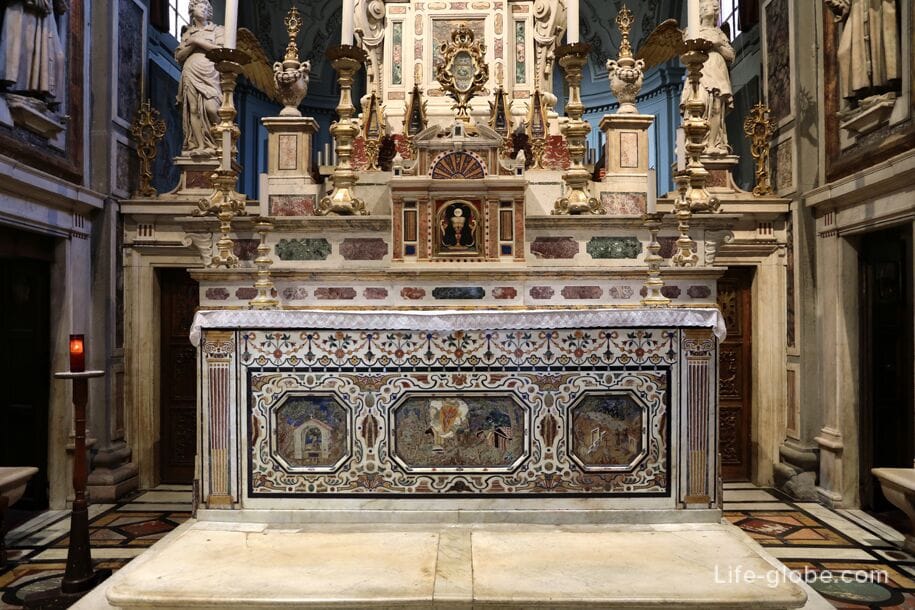
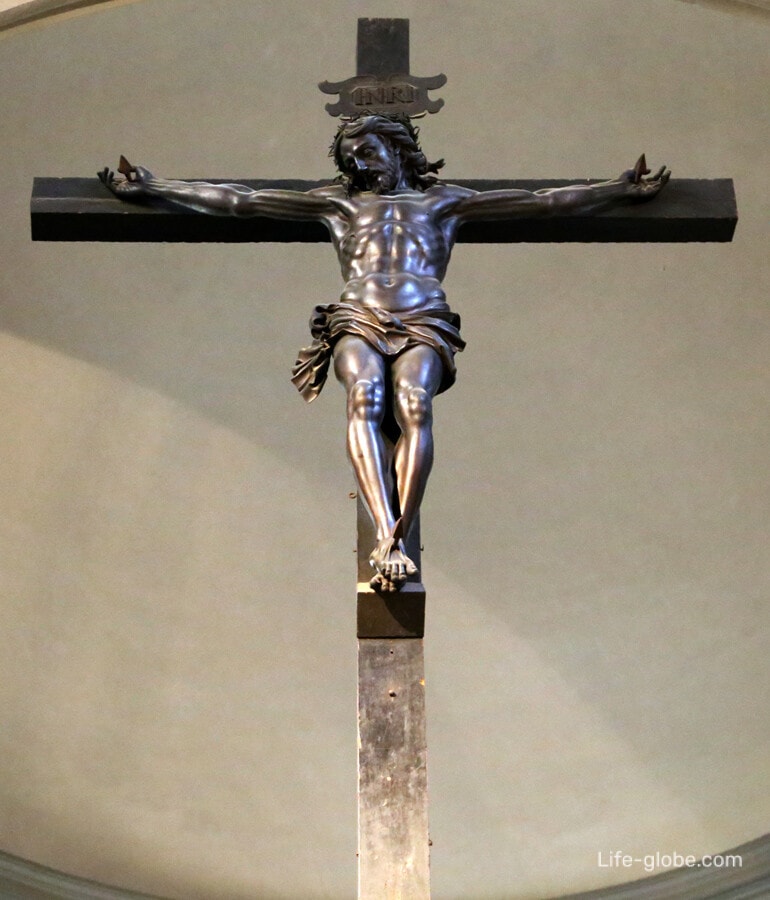
To the left of the main altar there is a sacristy door and a large cross of All Saints by Giotto (originally 1315), placed in the left transept in a raised chapel dedicated to the fallen.

Adjacent to the church of Oniissanti is a monastery with courtyards and a refectory, which houses the famous fresco by Domenico Ghirlandaio "The Last Supper" (dell'Ultima Cena; 400x810 cm.), dating from 1480.
Currently, the refectory works as a museum and is considered one of the secret gems of Florence.
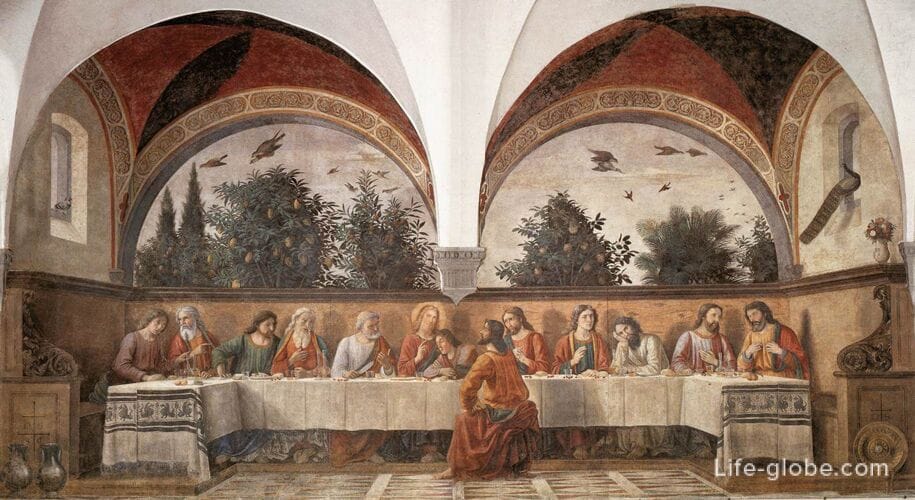
Practical information
Entrance to the Church of All Saints is free.
Website of the Church of All Saints: chiesaognissanti.it.
The address of the Church of All Saints: Borgo Ognissanti, 42, 50123 Firenze FI, Italy.
Coordinates of the Church of All Saints: 43°46'21.0"N 11°14'45.2"E (43.772497, 11.245883).
All accommodation facilities in Florence (hotels, apartments, guest houses, etc.), including in the historical center of the city and more remotely from it, can be viewed and booked here




